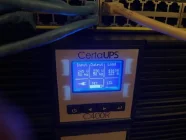How to Choose the Right Server Rack for Small Offices and Home-based Businesses
Many small businesses and especially those working from home, do not have a server room in which to house their server(s) and computer networking devices. Their IT systems are often run from a corner of their office, and this can lead to several issues including risks of accidental cable disconnection and trip hazards, security to prevent unauthorised access, noise pollution and heat generation. The way to solve these and other issues is to place the server and networking devices in a server rack. The problem is that a small office server system does not need the size and type of server cabinet used in a data centre.
What Type of Server Rack Do You Need?
Small home and commercial offices, very often only need a small server rack and the range offered by most server cabinet suppliers can seem a little daunting without some explanation. The most commonly available racks include:
- Wall Mounted Data Cabinets: have low loading capacities and are designed to house small IT devices including bridges and routers and may only have a front set of pillars to which to attach 19inch rack mounted devices or they can be fitted with shelves, such as modem shelves, bolted using M6 cage nuts to the front pillars. Some larger wall mounted data cabinets may also offer a rear set of pillars but neither the front or the back are adjustable, and the overall depth of the cabinet will be somewhere between 400-600mm. The data cabinet may arrive as a kit, for assembly on site and being ‘wall mounted’ may not have a backplate unless requested; the cabinet makes use of the rear wall. A lockable front door provides access through the front of the cabinet to the items inside. Typical wall mounted data cabinets include: 6U, 9U, 12U, 15U, 18U and 21U, with a standard 600mm width.
- Floor Standing Data Cabinets: some rack cabinet manufacturers offer floor standing data cabinets. These are more like the server racks one associates with a server room and offer a budget solution for users wanting a floor standing cabinet with a standard 600m width and either a 600mm or 800mm depth, in sizes that range up to 47U. Floor standing data cabinets can typically supplied assembled but may also be available as flatpacks with their bolted construction allowing for easy on-site assembly and installation. As with a wall-mounted data cabinet, front door will typically be one with a toughened tinted glass and the rear door perforated to provide ventilation (front to rear). Floor standing data cabinets are on castors for easy positioning and can hold, dependent on their size, up to 75Kg of computer kit. They offer 19inch racking and have adjustable mounting profiles.
- Open Frame Racks: floor standing racks can supplied as open-frame racks with no doors and sides. They provide a 4-pillar frame and are ideal where you need easy access to the equipment attached to the frame, from all sides. The frames themselves can be easily positioned under tables and worktops but they do have drawbacks in terms of more easily allowing dust and debris in, and won’t prevent unauthorised access; an important consideration when working from home with pets and children present.
- Floor Standing Server Racks Cabinets: This type of server rack is the most commonly used in computer rooms, server rooms and data centres. They are more robust than data cabinets and to accept to 250Kg or more of IT equipment, with depths ranging from 600-1200mm and widths from 600-800mm. Typical sizes range from 9U to 47U with 27-32U being the most used range. This style of server cabinet offers a range of options in terms of top or bottom cable entry, front and rear door using perforated for Airtech hex mesh for improved ventilation, cooling fan trays, and security locking options.
- Acoustic Server Racks: use acoustic dampening materials inside that will generally reduce overall noise levels by 20dBA compared to equipment housed in a standard server cabinet. Acoustic server racks will offer similar internal dimensions but will be deeper to allow for the cooling fans fitted to the draw air through the acoustic cabinets. It is important to make sure that AC powered cooling fans are UPS protected.
- Air Conditioned Sever Cabinets: are another specialist type of cabinet. Whilst a server cabinet is typically IP20 rated, air-conditioned cabinets are more sealed to IP-54 and have an air conditioner bolted to their sides. Whilst this provides cooler air into the rack internal spaces, the air conditioners vented into the space outside the racks. Air-conditioned server cabinets are more suited to industrial applications where the IT server racks require a cooler, cleaner, and more stable environment than that outside the cabinet.
Which Is the Best Server Rack for A Small Office?
For racking an IT server and computer peripherals, most home and small office users will look to use a free-standing server rack rather than a data cabinet. This is very dependent upon the depth of the IT servers and UPS if loaded into the cabinet. Where audible noise is an issue, an acoustic server rack will be the preferred choice, especially in more restricted spaces, due to the 20dB noise level reduction they can offer.
A 6-Point Server Rack Buyers Checklist
When choosing the right server rack for a small office or home environment, the following checklist may be useful.
- Equipment List: make a complete list of all the devices that will go into the rack including their U height (1U=44.45mm), depth, required cable radius and connection type, power demands (VA and Watts) and connections. This list will help you to decide on the most suitable rack height, width, and depth, and provide a load size for a UPS system if you need to provide battery backup in case of power outages.
- Cabling and Rack Layout: from this list you can use Microsoft Excel to create a rack layout drawing to help you decide where to position equipment in the rack. Ideally with the heaviest items placed on or near the bottom. The list will also help in deciding whether you need to add additional shelving to the racks (for small IT peripherals. Cabling routes (IT and power) can also be determined from the layout list, including the number of power outlets needed & their types you need, and whether you will need a power distribution unit (PDU) or not.
- Routing and Position: walk the route from outside your office to the final rack location. Make sure you identify all the obstacles and any obstructions, and that door widths are wide enough. If there is an issue, you may have to order a flatpack and assemble on site. Having a cabinet with castors should make positioning easier but make sure you make all cable connections, prior to final positioning if they will be difficult afterwards.
- Cooling and Air Flow: make sure there is sufficient air flow. Computers, servers, and uninterruptible power supplies draw cool air from their fronts and exhaust warm air through their rear panels. Air flow must be unobstructed to prevent ‘hot-spots’ and potential thermal build up within the cabinets. There must be sufficient room at the rear of the racks for the warm air to flow and rise and the cabinet sides should not be flush any other cabinets or walls.
- Temperature Monitoring: with most servers and IT systems left running 24/7 in small offices and home offices, it is important to install a form of temperature monitoring device. This should generate an alarm condition if there is an overtemperature which sent via email or email and SMS to the appropriate person.
- Rack Style and Colour: most suppliers offer racks in two colours (black or grey). Acoustic server cabinets may also be available with a wood panel finish, making them more aesthetic for home and office environments.
The above list is not exhaustive, and each individual installation may require additional considerations based on their site-specific and load characteristics.
Summary
The reliance of home-based businesses, small offices and remote workers on their IT systems running 24/7 continues to increase. Their investments in IT are significant and have led to growing demand for suitable server racks. Even with Cloud deployments, these users still retain an amount of equipment on site that must be safe and secure from unwanted intrusions and accidental cable disconnections, cooled & temperature monitored, and protected by a suitable uninterruptible power supply. The best way to do this is to use a server rack and approach the installation as one would for an organisation’s server room. Afterall, a single server rack is a micro datacentre, dedicated to providing IT services to the local and remote users.


























